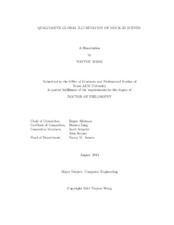Qualitative Global Illumination of Mock-3D Scenes
Abstract
In this work, we developed a framework to obtain qualitatively acceptable global rendering effects without an explicit geometry. This framework is particularly useful for 2D artists such as painters and illustrators. They will be able to obtain 3D looking images with complete artistic control as if they are using a 2D digital image manipulation system.
The core of this approach is a mock-3D scene representation that allows impossible or stylized shapes as “fuzzy” geometric structures. These fuzzy geometric structures are view dependent shapes that are computed from texture maps which provide normal, thickness and displacement information for all visible points of a shape. The information that is provided by these texture maps, which we call shape maps, do not have to be complete or consistent. Shape maps can be obtaining by (1) converting 3D shapes into 2D images, (2) modeling using a sketch based interface, (3) directly painting a gradient domain image or (4) photographing real objects. The most interesting shape maps are those sketched or painted by an artist, since they can reflect the artist’s intention, even if this does not follow the normal rules of perspective.
The major advantage of this approach is the ability to obtain visually acceptable global effects even when shape maps do not correspond to real 3D shapes. We show that computing view dependent fuzzy geometry from shape maps is sufficient to obtain qualitatively convincing global illumination effects even for impossible shapes. The methods we have developed and implemented for global rendering effects include ambient occlusion, local and global shadows, refraction and reflection. Although these methods do not directly correspond to underlying physical phenomena, they ii can provide results that are qualitative proportional to 3D realistic rendering.
Our approach is a very 2D artist-friendly representation since the shaders are also defined as images. These images can naturally describe shading parameters and provide a simple 2D control of the shading and rendering processes to intuitively obtain desired visual results. In particular, this representational power helps to easily obtain a wide variety of NPR effects that is still consistent with global illumination.
Citation
Wang, Youyou (2014). Qualitative Global Illumination of Mock-3D Scenes. Doctoral dissertation, Texas A & M University. Available electronically from https : / /hdl .handle .net /1969 .1 /157921.


